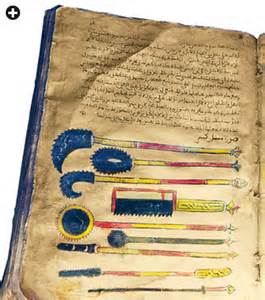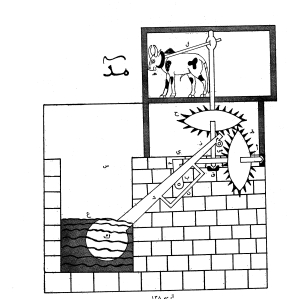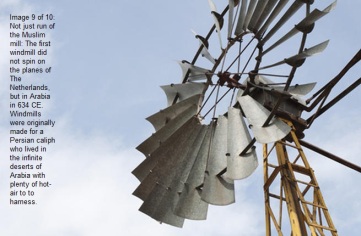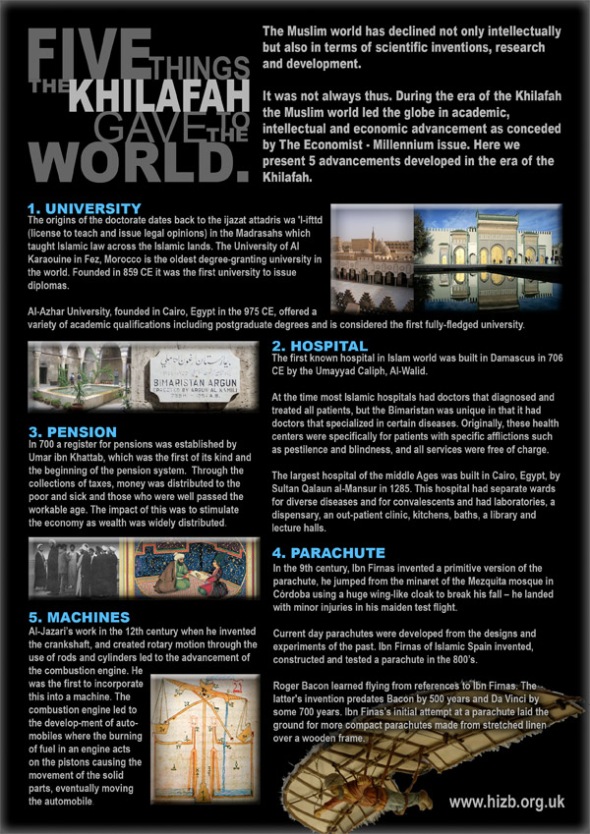6) Surgery
By the ninth century, Islamic medical practice had advanced from talisman and theology to hospitals with wards, doctors who had to pass tests, and the use of technical terminology.
In the words of Campbell “The European medical system is Arabian not only in origin but also in its structure. The Arabs are the intellectual forebears of the Europeans.”
Abu al-Qasim Khalaf Ibn Abbas al-Zahrawi (930-1013 CE)
-
known to the west as Abulcasis, Bucasis, is considered to be the most famous surgeon in Islamic medicine.
-
In his book Al-Tasrif, he described hemophilia for the first time in medical history.
-
The book contains the description and illustration of about 200 surgical instruments, many of which devised by Zahrawi himself.In it Zahrawi stresses the importance of the study of Anatomy as a fundamental prerequisite to surgery.
-
He advocated the reimplantation of a fallen tooth and the use of dental prosthesis carved from cow’s bone, and improvement over the wooden dentures worn by the first President of America, George Washington, seven centuries later.
-
Zahrawi appears to be the first surgeon in history to sue cotton in surgical dressings in the control of hemorrhage, as padding in the splinting of fractures, as a vaginal padding in fractures of the pubic, and in dentistry.
-
He introduced the method for the removal of kidney stones by cutting into the urinary bladder.
-
He was the first to teach the lithotomy position for vaginal operations.
-
He described tracheotomy, distinguished between goiter and cancer of the thyroid, and the invention of a cauterizing iron, which he also used to control bleeding.
-
His description of varicose veins stripping, even after ten centuries, is almost like modern surgery.
-
In orthopedic surgery he introduced what is called today Kocher’s method of reduction of shoulder dislocation and patelectomy. 1,000 years before Brook reintroduced it in 1937 .
Dr Al-Razi
-
Attributed to be the first to use the Seton in surgery and animal gut for sutures.
-
He was the first to use silk sutures and alcohol for hemostasis.
-
He was the first to use alcohol as an antiseptic (2).
Dr Ibn Sina
-
Originated the idea of the use of oral anesthetics.
-
The Arabs invented the soporific sponge, which was the precursor of modern anesthesia. It was a sponge soaked with aromatics and narcotics and held to the patient’s nostrils.
-
The use of anesthesia was one of the reasons for the rise of surgery in the Islamic world to the level of an honorable specialty, while in Europe, the Council of Tours in 1163 CE declared “Surgery is to be abandoned by the schools of medicine and by all decent physicians.” . Burton stated that “anesthetics have been used in surgery throughout the Muslim world for centuries before ether and chloroform became the fashion in civilized west..”
-
Ibn Sina’s description of the surgical treatment of cancer holds true even today after 1,000 years. He says the excision must be wide and bold; all veins running to the tumor must be included in the amputation. Even if this is not sufficient, then the area affected should be cauterized .
-
His recommendation of wine as the best dressing for wounds was very popular in medieval times.
They freely opened the abdomen and drained the peritoneal cavity in the approved modern style(laparotomy).
To an unnamed surgeon of Shiraz is attributed the first colostomy operation.
Liver abscesses were treated by puncture and exploration.
The surgeons of Islam practiced mainly three types of surgery; vascular, general, and orthopedic. Ophthalmic surgery was a specialty, which was quite distinct both from medicine and surgery.
Surgeons all over the world practice today unknowingly several surgical procedures that Zahrawi introduced 1,000 years ago.
7) PARASCHUTE
Abbas ibn Firnas was the first person to make a real attempt to construct a flying machine and fly. In the 9th century he designed a winged apparatus, roughly resembling a bird costume. His designs would undoubtedly have been an inspiration for famed Italian artist and inventor Leonardo da Vinci’s hundreds of years later.
8) The crank
Many of the basics of modern automatics were first put to use in the Muslim world, including the revolutionary crank-connecting rod system. By converting rotary motion to linear motion, the crank enables the lifting of heavy objects with relative ease. This technology, discovered by Al-Jazari in the 12th century, exploded across the globe, leading to everything from the bicycle to the internal combustion engine.
9) Refinement |
|
|
|
Distillation, the means of separating liquids through differences in their boiling points, was invented around the year 800 by Islam’s foremost scientist, Jabir ibn Hayyan, who transformed alchemy into chemistry, inventing many of the basic processes and apparatus still in use today – liquefaction, crystallisation, distillation, purification, oxidisation, evaporation and filtration. As well as discovering sulphuric and nitric acid, he invented the alembic still, giving the world intense rosewater and other perfumes and alcoholic spirits. Ibn Hayyan emphasised systematic experimentation and was the founder of modern chemistry. |
10) Windmill |
|
|
|
The windmill was invented in 634 for a Persian caliph and was used to grind corn and draw up water for irrigation. In the vast deserts of Arabia, when the seasonal streams ran dry, the only source of power was the wind which blew steadily from one direction for months. Mills had six or 12 sails covered in fabric or palm leaves. It was 500 years before the first windmill was seen in Europe. |








 About 1,600,000,000 cups of coffee are consumed every day around the world. Billions of people rely on it as part of their daily routines. And yet, very few people are aware of the Muslim origins of this ubiquitous drink. According to the historical record, in the 1400s coffee became a very popular drink among Muslims in Yemen, in the southern Arabian Peninsula. Legend goes that a shepherd (some say in Yemen, some say in Ethiopia) noticed that his goats became very energetic and jumpy when they ate beans from a particular tree. He had the courage to try them himself, noticing they gave him an energy boost. Over time, the tradition of roasting the beans and immersing them in water to create a sour yet powerful drink developed, and thus, coffee was born.
About 1,600,000,000 cups of coffee are consumed every day around the world. Billions of people rely on it as part of their daily routines. And yet, very few people are aware of the Muslim origins of this ubiquitous drink. According to the historical record, in the 1400s coffee became a very popular drink among Muslims in Yemen, in the southern Arabian Peninsula. Legend goes that a shepherd (some say in Yemen, some say in Ethiopia) noticed that his goats became very energetic and jumpy when they ate beans from a particular tree. He had the courage to try them himself, noticing they gave him an energy boost. Over time, the tradition of roasting the beans and immersing them in water to create a sour yet powerful drink developed, and thus, coffee was born. 
